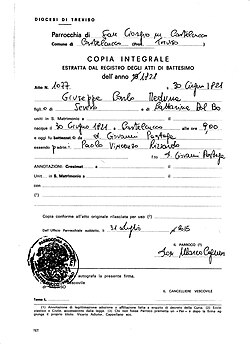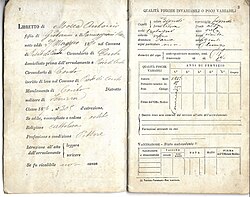Campania is a region in southern Italy, bordered by Lazio to the north, Apulia and Basilicata to the east, and the Tyrrhenian Sea to the west. Like much of Southern Italy, Campania’s political and administrative structure was shaped by the unification of the Kingdom of Naples and the Kingdom of Sicily, eventually becoming part of a unified Italy in 1861. The area was at various times under Spanish, French and Roman governance, which influenced the way records were created, organized, and preserved.
During the 18th and 19th centuries, Campania remained largely agricultural. The region operated under a feudal system well into the 1800s, with land ownership concentrated among the Church and absentee landlords. Despite some periods of economic activity, Campania and much of the south experienced limited industrial development and persistent social inequality, contributing to waves of emigration in the later 19th century. Today, Campania is divided into five provinces:
- Avellino
- Benevento
- Caserta
- Napoli (Naples)
- Salerno
These provinces contain a mix of urban and rural villages, coastal towns, and mountainous communities. If your ancestors came from Campania, they may have lived in a comune (municipality), which might include smaller frazioni (hamlets or neighborhoods). Understanding which comune your family came from, and which province it was part of during different time periods, is key to locating the right records.
Research your ancestors on MyHeritage
Types of family history records available in CampaniaTypes of family history records available in Campania
Census recordsCensus records
Population censuses have been taken in Campania every ten years starting in 1861. Census records up to 1991 are held in the state archive of each province. Starting in 1911 or 1921 (depending on the comune) a copy of the records could also be found in each comune’s register’s office (anagrafe). The availability to the public differs from comune to comune.
Vital recordsVital records
Church recordsChurch records

Before 1809, vital records were primarily kept by the Catholic Church. Parishes kept standardized records of baptisms and marriages starting in 1563 and deaths starting in 1614. These church records were usually written in Latin or Italian, although you may find occasional French records from the Napoleonic era. The structure of the Church in Italy is comprised of dioceses and parishes. A diocese is a regional office that oversees a number of parishes. In order to find specific vital records, you will need to know the name and location of the parish that holds those records. If the parish still exists today, you can contact the records office there to do a search. If the parish has been closed, contact the diocese office to determine where the records are currently stored. Consult an Italian Church directory to get started.
The Church also ran a number of orphanages throughout southern Italy. The birth records of orphans were sometimes recorded at the parish where the birth occurred, and at other time at the parish that housed the orphanage. You will have to check both places. Orphan records were usually recorded in the second part of the record book. The largest orphanage in Campania was the la Casa Santa dell'Annunziata in Naples.
Civil recordsCivil records

In the early 19th century, Napoleon’s armies conquered large portions of Italy, and implemented the French system of state-run civil registration records. In Italy, these were called the “registry dello stato civile”.
Civil registration records are the vital records created by the government. Civil registration was required in Campania starting with the Napoleonic era in 1809. Some parts lagged behind others, but all of Campania was recording civil records by 1820. These were recorded by the municipal registrar (Uffiziale dello Stato Civile) and kept at the local (comune) level. These include birth, marriage, and death records. In addition, civil registration may include documents required for marriage, miscellaneous records (such as stillbirths), deaths occurring in other cities or countries, and legitimations or parental acknowledgments [ricognizioni]. Civil records can be found online at the Portale Antenati (Ancestors Portal), a project overseen by the Italian government. You will need to search for records in two steps:
First, identify the town or city in Campania where the record (birth, marriage, death) originated. Second, estimate the year in which the record might have been created. Antenati records are divided into three time periods:
- Stato Civile Napoleonico (1806 – 1815)
- State Civile Della Restaurazione (1815 – 1865)
- Stato Civile Italiano (from 1865 onwards)
Family Status Certificates (certificati dello stato di famiglia)Family Status Certificates (certificati dello stato di famiglia)
Family Status Certificates Records have been issued since the late 1860’s. They are arranged into family groups and give a glimpse into the life of a family unit. The records can include data on several generations of the same family. They may include such information as:
- The given name and surname of the head of the household and all individuals in that household, and the relationships to the head of household.
- Names of parents of named persons, including the maiden name of the mother.
- Profession.
- Place and date of birth.
- Place and date of death.
- Marital status.
- Residences of family members who have moved from the community and the date of departure.
These records are kept at local municipal archives. The collections usually cover most of the community, however, some municipalities may have disposed of earlier records. Access is often limited to staff only. Researchers will usually have to make a request to get copies. There has been some work in the last few years to allow researchers to request copies online, however this varies by municipality.
Military recordsMilitary records

Since the creation of the Italian state in 1861, all Italian males, with certain exceptions, have been subject to military duty. This requirement can generate a number of records that can be useful in genealogical research.
Liste de Leva & Lista d’EstrazioneListe de Leva & Lista d’Estrazione
The liste di leva are military draft lists documenting 18-year-old males in Italy, while the Lista d'Estrazione tracks those same men at the age of 21. The process had two phases:
- Phase I: Each town submitted an annual list of males born 18 years prior to the local military district. These lists included the individual’s name, parents’ names, birthplace, and residence. The military office compiled these into the lista di leva and added further details such as physical traits, marital status, and current address.
- Phase II: At age 21, eligible men were examined by a draft board (consiglio di leva). The results, including physical condition, occupation, and exemption status, were recorded in the lista d’estrazione. Exemptions could be granted for medical, legal, or social reasons (for example, being a family's only surviving son).
Service and Discharge records (Foglio di Congedo Illimitato)Service and Discharge records (Foglio di Congedo Illimitato)
These records describe a soldier’s time in service and legally prove his discharge from military service. They can include birth information, parents’ names, physical description, vocation, and educational information. They also give information regarding the date and place of draft, length of service, transfers, campaigns, medals, and wounds. Typically, the soldier received one copy and the other was kept in the military file.
Finding military recordsFinding military records
Italian military records that are less than 75 years old are kept by the local tribunal (court) archive for that district and are not public. After the 75-year mark they are released to the provincial archive and are made public. The Portale Antenati is currently digitizing archive records: the archives for Avellino, Benevento, Caserta, and Salerno are complete, while Naples is still in progress.
Immigration and EmigrationImmigration and Emigration
The first Italian diaspora, from the 1880s through the 1920s was a time when millions of Italians left for other countries. They were fleeing harsh conditions, poverty and food insecurity. Popular destinations were Brazil, Argentina, Venezuela and Uruguay in South America; and the United States and Canada in North America. Most southern Italian immigrants left through the Port of Naples.
Unfortunately, departure records from Italian ports are rare. It is much more common to find passenger manifests and immigration records in the receiving countries. These records can include such information as names and relationships, town and port of departure, occupation, and in some cases, the name and address of a person that was meeting the travelers in the new country.
Tax Records (Riveli di Beni e Anime)Tax Records (Riveli di Beni e Anime)
Historical tax records are usually kept at the state archive for the associated town (comune). These records, called Riveli di Beni e Anime (Records of Good and Souls) are valuable genealogical sources used to identify individuals within a specific locality. These records document tax assessments on real and personal property and may include the individual's name, age, civil status, and occasionally the names of parents.
Depending on the year and region, some records list all household members, while others name only the head of household, along with a valuation of the family's assets. Records can go back as far as the 1600s in some cases

